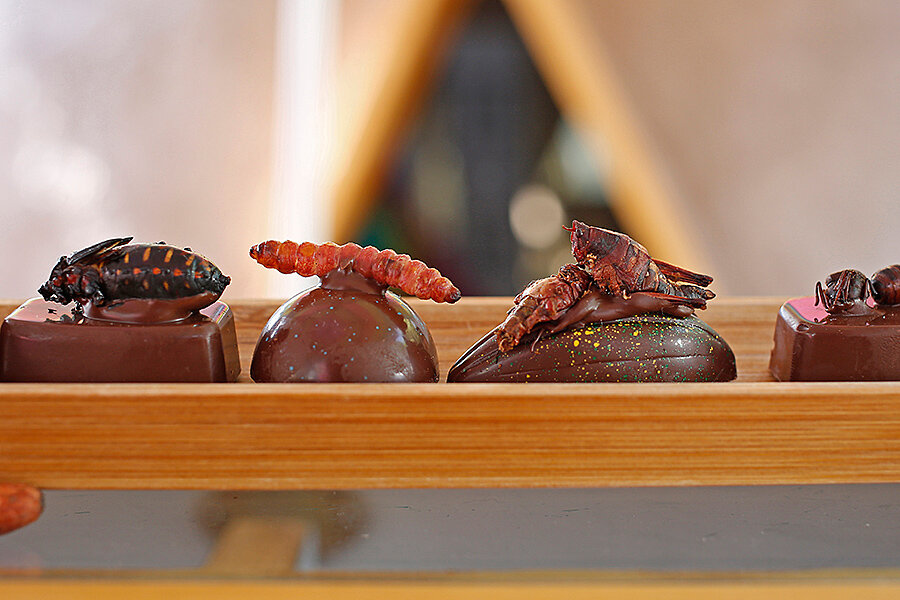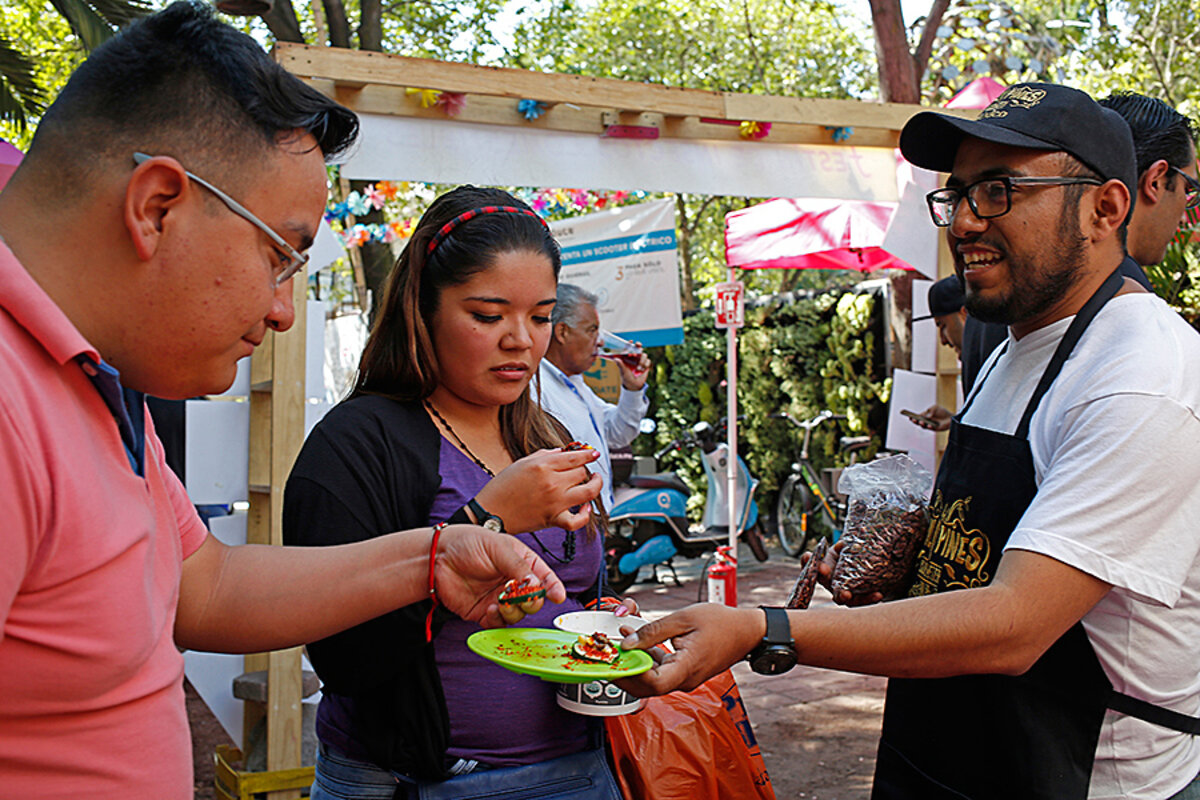Edible insects give Mexicans a taste of history – and maybe the future
Loading...
| Mexico City
At first glance, the stalls set up in this neighborhood garden look like they could be part of any typical farmer’s market. There are the men selling artisanal chocolates, the bread maker stacking her loaves precariously high, and the couple slinging tortillas over a smoking comal, or griddle.
But upon closer inspection, there’s something buggy about this scene. Literally.
A glistening cockroach is perched upon that square of chocolate. There are crispy brown grasshoppers cooked into that bread. And the tortillas? Smeared with fly eggs and garnished with a spicy green salsa.
This is the third annual Festival of Edible Insects, and the crowded passageways between the horseshoe of stalls is a testament to the growing resurgence in popularity of this centuries-old Mexican culinary tradition, amid a broader uptick of interest in Mexico's heritage that goes beyond its borders.
Eating bugs “is confused with being something exotic,” not just by foreigners, but by many city-dwelling Mexicans as well, says Isaac Sandoval, co-owner of the Época de Oro Chocolateria, who is serving up critter-covered chocolates.
“This is tradition and is a huge part of Mexico’s story,” Mr. Sandoval says.
The Mesoamerican diet has long included hundreds of species of insects. Although many rural and small towns across the country have held on to the tradition, it fell out of favor in bigger cities where bugs are more often associated with rolled-up newspapers than nutrition.
But it’s having a renaissance, both in Mexico and internationally. Some vendors here today export their products, like Chilipines Gourmetier, which sells legless grasshoppers (less crunch getting stuck in one’s teeth) destined for Switzerland, Spain, and Canada. And top Mexican chefs have helped amp up the “cool factor” of edible insects in recent years with the inclusion of things like soft, cream-colored ant eggs in omelets at popular brunch spots, or crunchy grasshoppers mixed into guacamole at restaurants with white table cloths.
Insects on the menu are part of a broader, global interest in Mexican culinary and artistic traditions, says fair organizer Enrique Cervantes, who is sporting a green foam hat shaped like a grasshopper. “Frida [Kahlo], mezcal, pulque, mole, anything from Oaxaca, really,” says Mr. Cervantes. “There’s more of an interest in Mexican food and culture world-wide.”
Top Mexican chefs who feature traditional ingredients and recipes have opened restaurants in places from New York City to Dubai, and Mexico City was featured as the top place to visit in 2016 by The New York Times. Two-thirds of Americans have favorable views of their southern neighbor, according to a February Gallup poll. That's the highest percentage in a decade, despite the prevalence of headlines about drug trafficking and violence in US coverage of Mexico.
And ever since US President Trump cannon-balled into the US political scene, there’s been greater interest in Mexico from within Mexico, too, Cervantes says. After months of jabs from north of the border about Mexicans as criminals, or dragging the US down, “Mexico and its traditions are finally being valued by Mexicans,” he says. For decades before, he feels, people were “down on Mexico,” prioritizing US or European culture. “But little by little, we're starting to love ourselves.”
“We are starting to find our own force, what we can offer the world,” he adds, leaning back in a plastic chair and watching as festival-goers flow in from the street. “We have this incredibly rich gastronomy and ingredients that are historic and so unique…that’s something we can take pride in.”
Bug-eating, in particular, is “like eating history,” he says.
Nineteen-year-old Bruno Ituarte came to the festival because he was interested in expanding his bug-eating repertoire. “I’m from Mexico City, so I didn’t grow up eating these things,” he says, taking an audibly crunchy bite of his cockroach con chocolate. “I’ve had chapulines (grasshoppers) and tried gusano de maguey (agave worms) once or twice,” he says. “People in the city can be hesitant, but you see a bug in the street and that’s one thing. These bugs are harvested and farmed. And really, they take on the flavor of what they’re cooked in.”
A few stalls away, Jesus Ortiz and Uveira Cruz Soriano, who started a collective in Oaxaca dedicated to gathering and promoting insects eaten in pre-Hispanic times, disagree. Mr. Ortiz and his wife are preparing traditional Oaxacan tlayudas (flatbreads) and topping them off with insects big and small. The end results are colorful masterpieces in hues of reds, oranges, and greens. He rattles off the names of the dozens of creepy-crawly delicacies laid out at his stand: chapulines, chicatanas, cuchamas, cocopaches, and condaches are just a few.
“Each bug has its own distinct flavor,” he says. He’s here today because of the importance he sees in teaching Mexicans about their own history and culture. “Food is part of our genetic map. If we don’t teach our kids to gather grasshoppers with nets from crops or what season the chicatanas come out, we’ll lose this history,” Ortiz says. “My grandkids eat grasshoppers with beans and think it’s delicious.”
He also sees a bright future in including bugs in all diets, citing a 2013 report published by the United Nations saying insects are a valuable source of protein, and could be an environmentally friendly key to fighting global hunger. Feeding the world in 2050, the report notes, will likely require twice the food produced today – and insects, whose cultivation requires less land and produces fewer greenhouse gases compared to traditional meats, could be one way to fill that gap.
Bug-eating in the future, however, depends on sustainable choices in the present. Despite the excitement around entomophagy here today, some vendors say it’s not just about teaching history and the joy of cooking with insects that’s important. Maintaining an environment where these insects can continue to hatch is paramount.
Guillermo Barragan, who also goes by the name “Don Aceituno,” or Sir Olive, gives out olive samples in front of his wife’s stall where she’s hawking snacks made of ground-up fly eggs. His family is from Mexico State, and for generations has gathered fly larvae called Axayacatl around his town’s brackish lakes. The eggs, sometimes referred to as Mexican caviar and named after an Aztec emperor, have become increasing difficult to harvest, Mr. Barragan says.
“Climate change and urbanization have wiped out” much of the marshy environment where these eggs are traditionally laid, he says. Now he and his neighbors plunge pine fronds into the water’s edge, creating a substitute habitat for the Axayacatl to lay their eggs.
On the other side of the market, near a stand selling donuts with caramelized grasshoppers and another appealing to the most daring attendees with scorpion delicacies, is Mario Redondo. Five years ago, in a college course, he hatched a business plan to start exporting Mexican food products like crispy grasshoppers sprinkled with chile and salsas with ground up grasshoppers and fruits.
“Sure, eating bugs is trendy,” he contends. “But that doesn’t mean it’s fleeting.”







